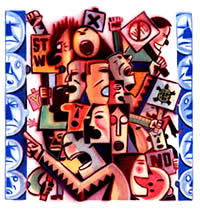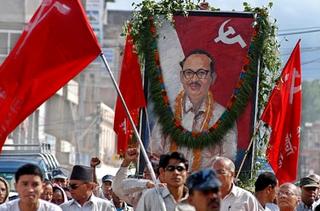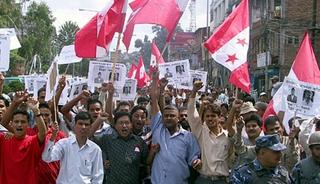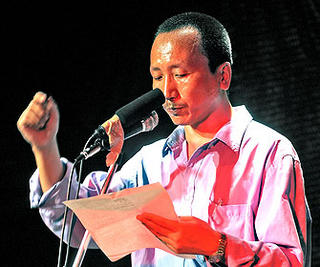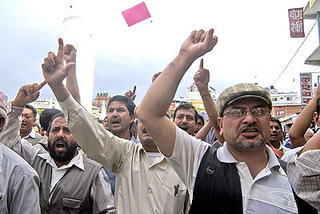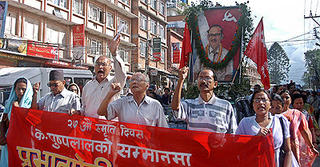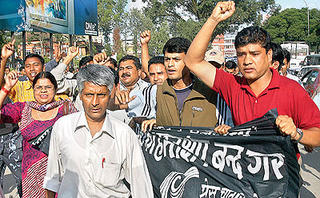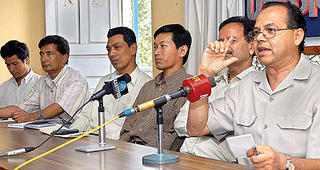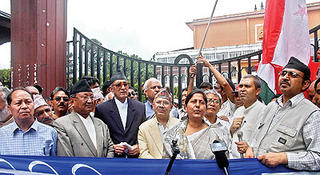
AI Index: ASA 31/054/2005 Amnesty International July 2005
TABLE OF CONTENTS
Children killed in the conflict ……………………………………………………………….1
Children detained and tortured…………………………………………………………….. 4
Sexual violence against children……………………………………………………………. 6
Impact of the conflict on education ………………………………………………………....8
Child abduction and recruitment…………………………………………………………. 10
Children from fractured families ………………………………………………………….12
Progress on child rights undermined……………………………………………………... 13
Conclusion…………………………………………………………………………………... 15
Recommendations……………………………………………………………………..…….16
AI Index: ASA 31/054/2005 Amnesty International July 2005
Nepal
Children caught in the conflict
Nepal has been gripped by a brutal internal armed conflict between the security forces and
Communist Party of Nepal (CPN) (Maoist) rebels for the last nine years, during which more than 12,000 people have died. Nepal’s civilians are caught between the two sides and are experiencing extreme violence and hardship. While the violence is affecting all sections of society, Nepali children are being impacted particularly harshly and in very specific ways.
The most fundamental rights of children, provided by general human rights treaties and
particularly by the UN Convention on the Rights of the Child (CRC), as well as by international humanitarian law treaties and rules of customary international law, have been violated. Children are being killed deliberately or in indiscriminate attacks, illegally detained, tortured, raped, abducted and recruited for military activities.
Many Nepali children have for a long time experienced extreme poverty, lack of access to basic services, discrimination against girls and Dalit children, trafficking and sexual and commercial exploitation. The conflict is exacerbating many of these already existing abuses and eroding recent progress towards improving the lives of children.
Children killed in the conflict
According to children’s NGOs1 at least 400 children have died in conflict related violence since 1996. However, with little information available from Nepal’s most remote districts and with many families inhibited from reporting killings due to widespread fear and no hope of justice, the true number of children killed is likely to be far higher.
Extrajudicial executions by the security forces have been a constant feature of the conflict and the scale of these killings has increased significantly in the last year2. There have been a
number of reports of children being extra-judicially executed by security forces, as well as killed in armed “encounters” with the security forces. Such reports raise concern that, in addition to committing the grave human rights violation of extrajudicial executions, security forces do not distinguish between adult and child combatants or suspects. In June 2005, the Committee on the Rights of the Child expressed its concern “that
1 Statement of CWIN Nepal on the Follow-up Report of Convention on the Rights of the Child Submitted by HM Government of Nepal, 1 February 2005, Geneva
2 For more information on extrajudicial executions by the Nepali security forces, see Amnesty International’s report Nepal: Killing with impunity (AI Index: ASA 31/001/2005).
2 Nepal: Children caught in the conflict
Amnesty International July 2005 AI Index: ASA 31/054/2005
government forces target under-18s suspected to be members of the armed groups”.3
There have also been reports that CPN (Maoist) have deliberately killed children. For example, in August 2004 CPN (Maoist) cadres reportedly shot and killed 15-year-old Santosh Bishwakarma of Medebas VDC, Dhankuta district. A CPN (Maoist) source claimed he had been killed as punishment for committing incest and collecting donations while posing as a CPN (Maoist) cadre. Likewise, on 15 April 2005 the CPN (Maoists) reportedly attacked Bargadwa village in Nawalprasai district, killing 10 civilians including one child. Families of security forces personnel, including children, have also been targeted by the CPN (Maoist). On 14 June it was reported that two women and a one-year-old child, who were relatives of Armed Police Force personnel, were abducted by the CPN (Maoist) in Banbehada of Chaumala VDC, Kailali district and their mutilated bodies found two days later in a community forest.
CPN (Maoist) practices of indiscriminate attacks and attacks targeting civilians and civilian
objects - both of which are prohibited under treaty and customary international law and constitute international crimes - also result in the deaths of children. On 6 June 2005 seven children were killed, along with 31 adults, when a passenger bus was bombed by the CPN (Maoist) in Kalyanpur VDC, Chitwan district. The CPN (Maoist) had reportedly targeted the bus because there were security forces personnel travelling on it, although following a public outcry the CPN (Maoist) leadership later issued an apology for the attack. However, the death of children in such CPN (Maoist) attacks is not new. For example, on 22 February 2002, an 8-year old child was burned to death, together with four adults, when the CPN (Maoist) set fire to a bus travelling from Kathmandu to Birganj.
As well as being directly targeted by both sides to the conflict, it is estimated that hundreds more children have died from mines, bombs and improvised explosive devices (IEDs) used by both the CPN (Maoist) and the security forces. Indicating the extent of the casualties, the Nepal Campaign to Ban Landmines reported that mines and unexploded ordinance had killed 92 children during
3 Concluding Observations of the Committee on the Rights of the Child: Nepal, UN Doc. CRC/C/15/Add.260, 3 June 2005. para 81.
At around 4am on 13 February 2004, in Pokhari Chaur Village Development Committee (VDC), Kavre district, 17-year old Subhadra Chaulagain was reportedly taken from her home by security forces during a search operation. She was taken to a nearby spot where she was interrogated before being shot in the face and stomach by security forces. In a similar incident, on 3 September 2004 a group of security forces personnel allegedly followed three girls - Hira Ram Rai aged 15, Jina Rai aged 16, and Indra Kala Rai aged 16 - from their school in Basikhora village, Bhojpur district and shot them when they entered a nearby forest. Although the girls were reportedly members of a local CPN (Maoist) cultural group they were unarmed. The government radio station later carried news that the three girls had been killed in an “encounter” in a different district.
Nepal: Children caught in the conflict 3
Amnesty International July 2005 AI Index: ASA 31/054/2005
the first half of 2004 alone4. A particular threat to children is the CPN (Maoist) practice of
planting IEDs, including very unstable “socket bombs”5 in civilian areas, where they are found by children. Recent reports of children killed by IEDs include 14-year old Ashok Yadav, 10-year old Saroj Yadav and 11-year old Mahesh Yadav from Janakpur, Dhanusha district, who were killed on 27 March 2005 while playing with an IED, as well as five children killed and three injured on 22 April 2005 when an IED left at a public tap exploded in Dalsing, Rukum. Children are also killed in crossfire during fighting. For example, on 9 December 2004 an 8-year old girl, Sushi Karki was shot and killed during a gun battle between the CPN (Maoist) and security forces while standing on the balcony of her home at Priti village, Ramechhap district.
In addition to these violent deaths there is little doubt that many more children are dying from poverty and disease exacerbated by the conflict. With more than half Nepal’s population living on less than a dollar a day, Nepali children are already facing severe threats to their right to enjoyment of the highest attainable standard of physical and mental health and their right to life, with government figures revealing that approximately half Nepal’s children experience stunted growth due to malnutrition, while 30,000 children under 5 die each year from diarrhoea.6 The destruction of vital infrastructure, widespread insecurity, and frequent CPN (Maoist) blockades have damaged vital services and severely impeded access to food and healthcare for children in many areas.
Many parts of the country have experienced food shortages, as supplies are disrupted by the
conflict. On 10 April 2005 the World Food Programme (WFP) reported that, due to the growing insecurity, it was facing serious difficulties implementing its programmes, which include food for education initiatives and the provision of food to 100,000 Bhutanese refugees in eastern Nepal who are entirely dependent on such food deliveries. Both the CPN (Maoist) and the government of Nepal have restricted supplies of food and other essential goods to particular areas as part of their military strategies, in clear contravention of provisions of the Geneva conventions that are binding on both sides.7 On 9 June 2005 it was reported that 12 mountainous districts were facing food shortages as the conflict had prevented government food deliveries reaching them. There is no doubt that children, especially those from the poorest communities, are being severely affected by such food shortages.
Vital health services are also threatened. For example, on 21 September 2004 the CPN (Maoist) bombed a District Health Post in Udaypur district, destroying the stock of measles vaccine intended for immunizing children throughout the district. Likewise on 20 January 2005 the District Health Office in Baitadi district reported that a measles vaccination programme had to be
4 Quoted in report Watchlist on Children and Armed Conflict, Caught in the Middle: Mounting Violations Against Children in Nepal’s Armed Conflict, January 2005, p. 33. The report is available on http://www.watchlist.org/reports/nepal.report.20050120.pdf.
5 Reportedly made from the spring of a ballpoint pen.
6 Committee on the Rights of the Child, Second Periodic Report of States Parties: Nepal, UN Doc. CRC/C/65/ Add.30, 3 December 2004. para 219.
7 While the CPN (Maoist) has blockaded highways and towns, including Kathmandu, the security forces have reportedly stored food and medicines in district headquarters, allowing only small amounts at a time to be delivered to rural areas, in an effort to prevent supplies falling into the hands of the CPN (Maoist).
4 Nepal: Children caught in the conflict
Amnesty International July 2005 AI Index: ASA 31/054/2005
suspended in 22 VDCs across the district, due to a CPN (Maoist) bandh8. On 18 March 2005 a
joint statement by donors and the United Nations in Nepal warned that “Insecurity, armed activity and the CPN/M blockades are pushing Nepal toward the abyss of a humanitarian crisis. Children are especially threatened: supplies of vaccines, vitamin A capsules, de-worming tablets and essential drugs must reach rural areas over the coming months to prevent wholly avoidable deaths”9.
The deliberate killing of children is a clear violation by the Nepali state of its obligations under
the CRC, as well as under the International Covenant on Civil and Political Rights (ICCPR), to
both of which Nepal is a state party, as well as both state and CPN (Maoist) obligations under
international humanitarian law10. The targeting of civilian infrastructure, including food, medical supplies and educational institutions is similarly prohibited under international humanitarian law. Both constitute war crimes.11
Children detained and tortured
Amnesty International (AI) has received disturbing reports of children suspected of affiliation to the CPN (Maoist) being detained for long periods in army barracks, police stations or adult
prisons, often held incommunicado without being subjected to any legal process. This is despite the claim made by Nepali government officials during the consideration of the second period report of Nepal to the Committee on the Rights of the Child on 20 May 2004 that “there were no children in Nepalese prisons” and that all child detainees are held in child cells within district detention centres or child correction centres.12 Some child detainees report being tortured by the security forces during their detention.
In February 2005 AI delegates met two 15-year old boys in Kathmandu jail, Govinda Pariyar
from Tanahu district and Somu Bahadur Moktan from Ramechhap district, who is mentally
disabled and unable to communicate properly. These boys were arrested by Royal Nepalese Army (RNA) personnel in summer 2004 on suspicion of being associated with the CPN (Maoist). After their arrest they were held for 11 days in an army barrack where they were severely beaten with pipes and kicked with boots. Govinda told AI delegates that during the interrogation and torture, Somu replied “yes” to every question posed by the security forces, causing them to believe that the two boys were associated with the CPN (Maoist), despite the fact that Somu’s mental disability is very obvious. After the 11 days they were transferred to prison, where they have remained for the past nine months. Govinda’s face is badly scarred from the beating; he is
8 Bandhs are general strikes called by the CPN (Maoist) in which all commercial, transport and other services are forced to shut down for a specified period. These bandhs are enforced with the threat of violence.
9 Statement by CIDA, Danida, DFID, European Commission, GTZ, SNV, SDC, USAID, the Embassy of Finland, the Norwegian Embassy and the United Nations, 18 March 2005.
10 Article Three, common to the Four Geneva Conventions of 1949, which applies to armed conflict not of an international character, requires all parties to the conflict to ensure humane treatment of those not participating in the conflict and prohibits “violence to life and person, in particular murder of all kinds”. These are also rules of customary international law binding on all parties to armed conflicts.
11 See for instance the Rome Statute of the International Criminal Court, Articles. 8(2)(e)(i), 8(2)(e)(ii) and 8(2)(e)(iv).
12 Committee on the Rights of the Child, thirty-ninth session, Summary Record of the 1033rd Meeting, UN Doc. CRC/C/SR.1033, 27 May 2005, para. 12
Nepal: Children caught in the conflict 5
Amnesty International July 2005 AI Index: ASA 31/054/2005
disturbed and often screams at night. The boys have been given a detention order but neither of them has seen a lawyer and they have no idea when they may be released.
In a similar case, Bishna Bishwakarma, of Ghatgaum VDC, Surkhet district - now a 19-year old woman - was reportedly arrested by the police at the age of 15 after she joined the CPN (Maoist). She was held in Surkhet district police station for just over one month and during the first seven days of her captivity she was allegedly punched and beaten with a pipe by the policemen, who also shouted obscenities at her. After being brought to court on terrorist related charges Bishna was transferred to Surkhet jail where she has remained in custody for four years. Bishna reports having made an initial court appearance but she apparently has not been sentenced. She is unsure of her legal status.
Security forces have also been responsible for the “disappearance” of children, who have been
held in incommunicado detention while the authorities have denied their arrest. Manoj Rai, a 15-year-old student, was arrested by police in Kathmandu on 27 September 2003 and taken to Hanuman Dhoka District Police Office (DPO), where he was allegedly tortured. On 28 November 2003 lawyers from a local human rights organisation found Manoj being held in unacknowledged detention in Hanuman Dhoka DPO and a habeas corpus petition was filed. However, the police denied his arrest and all knowledge of his whereabouts. In December 2003 the National Human Rights Commission (NHRC) discovered Manoj in a different police station, still being held in unacknowledged detention. Manoj was finally released on 1 January 2004, a day before the date set for a Supreme Court hearing on the case. He was told to report back daily to the police, but apparently went into hiding fearing for his safety.
Nepali security forces have demonstrated a consistent disregard for the rule of law and the
authority of the courts, regularly misleading the courts and immediately re-arresting those
released on the orders of a judge. This undermines the authority of the courts, the legal
protections available to both adult and child detainees13 and the rule of law in general. For
example, 16-year-old Jhurri Teli of Belhiya VDC, Banke district was arrested on 9 September
2004 in Nepalganj. He was allegedly beaten and interrogated, before being taken to an army
barracks, where he was kept for seven days blindfolded and with his hands tied behind his back. Following this he was transferred to the district police office and from there to Banke prison. In response to a habeas corpus writ, on 28 November the appellate court found Jhurri’s detention to
13 Including the prohibition of arbitrary detention, as provided in Article 9(1) of the ICCPR and Article 37(b) of the CRC.
Even very young children have been detained and tortured by the security forces. In
September 2004, Chandra Malla, of Latikoili VDC, Surkhet district told AI how, after her
husband was killed by security forces in 2001, the police came to her home and arrested her
10-year old son. They dragged him from the house and beat him with a pistol while accusing
him of being a Maoist. The boy was held in custody for 6 days, during which time he was beaten with a plastic pipe all over his body. After he was released the security forces continued to visit his home and threatened to rape his 12-year old sister.
6 Nepal: Children caught in the conflict
Amnesty International July 2005 AI Index: ASA 31/054/2005
be illegal and ordered his release. However, when he was released the following day he was
immediately rearrested and taken away by police in front of his lawyers.
Such cases demonstrate Nepal’s apparent disregard for its obligations under the CRC to ensure that children deprived of their liberty are separated from adults (Article 37(c)), have access to prompt legal and other appropriate assistance (Article 37(d)) and are not subjected to torture or other ill treatment (Article 37(a)).14 There is no effective juvenile justice system in Nepal and the few juvenile detention facilities that do exist are overcrowded, resulting in many children being kept in adult jails. Although in April 2000 provisions were made to establish juvenile benches in each district, in many districts this bench is not functioning and children who do go through a legal process are often dealt with by quasi-judicial District Administration Offices. This is despite the stated policy in the Nepal government’s tenth plan (2002 – 2007) of “establishment of legal system in line with children’s rights”.15
Moreover, in the context of the armed conflict, with draconian anti-terrorist laws in place and an increasing disregard among the security forces for the rule of law, the already weak protections for child detainees are being further eroded. In June 2004, the Committee on the Rights of the Child expressed its concern at reports of children being held in detention under the 2004 Terrorist and Disruptive Activities (Control and Punishment) Ordinance (TADO), which allows for preventive detention for up to one year.16
It is clear that the Nepali state’s treatment of children in detention is in violation of the CRC, which provides, in Article 37(c), that “every child deprived of liberty shall be treated with humanity… and in a manner which takes account of the needs of persons of his or her ages. In
particular, every child deprived of liberty shall be separated from adults… and shall have the right to maintain contact with his or her family”. Article 37(a) provides that “No child shall be subjected to torture or other cruel, inhuman or degrading treatment or punishment.” Torture, cruel, inhuman and degrading treatment of children are also violations of Nepal’s obligations under the ICCPR, The UN Convention Against Torture and the Geneva Conventions.
14 These rights are also provided for in other international treaties to which Nepal is a state party, including the ICCPR, The UN Convention Against Torture And Other Cruel, Inhuman Or Degrading Treatment Or Punishment and the Geneva Conventions.
15 Section 26.2.3 of Tenth Plan (2002 – 2007), His Majesty’s Government, National Planning Commission, Nepal, March 2002.
16 Concluding Observations of the Committee on the Rights of the Child: Nepal, UN Doc. CRC/C/15/Add.260, 3 June 2005, para. 81.
Nepal: Children caught in the conflict 7
Amnesty International July 2005 AI Index: ASA 31/054/2005
Sexual violence against children
Sexual exploitation of children has for a long time been a serious problem in Nepal and the
conflict has both exacerbated this exploitation, as well as produced new forms of sexual violence.
There have been a number of reports of girls being raped by security forces during “search
operations”. Shanta (not her real name), who estimates her age at 15 or 16, lives with her husband and mother in the mid-western region. Shanta told AI delegates that in early 2004, when army personnel came to her house in the middle of the night to interrogate her husband, one of the soldiers took her to the family’s cattle shed where he raped her. She has never made a complaint about the attack because of fear of reprisal from the army. Shanta is a member of the marginalised Tharu community, which has been a particular target of sexual violence by “higher caste” communities and the security forces.
In October 2004, AI delegates met Renu (not her real name), a 16-year old Tharu girl from
western Nepal. Renu told the delegates that in spring 2004, two policemen dragged her at
gunpoint from a friend’s house, where she had gone to attend a wedding. She was taken to a
nearby river where she was repeatedly raped by the policemen until she lost consciousness.
When she awoke she was bleeding heavily and managed to struggle back to her friend’s house. However, the policemen followed her there and spent the night taunting her, beating her friend’s family and threatening to rape her again.
The next day her friend’s family carried Renu, who was severely injured from the attack, to
the police station to make a complaint. However, the police officer she spoke to advised her not to lodge a complaint because it would bring shame on herself and her family. Bleeding very badly, Renu was taken to a local clinic but the police prevented her from being transferred to a major hospital for the treatment she needed.
On returning to her village Renu did not tell her family what had happened to her because she
was ashamed, but rumours spread that she had been raped and she finally told the school
authorities about the incident. Once the rape was disclosed Renu was taken to the district
headquarters by a local NGO, which, she claims, forced her to file a court case and speak to
journalists about the attack. She reports that she was repeatedly questioned by journalists while staying with the NGO and, referring to this treatment by the media, told AI “I was raped once by the security forces but raped 20 times by the others [journalists]”.
Finally Renu was taken by a different NGO to Kathmandu where she received the hospital
treatment she required. She has not returned to her village because of the stigma she faces as a rape survivor and now lives in a women’s refuge in Kathmandu. She has not been able to return to school as her injuries prevent her from sitting for prolonged periods.
Although the two policemen were suspended, Renu’s family continue to receive threats not to
bring charges against them.
8 Nepal: Children caught in the conflict
Amnesty International July 2005 AI Index: ASA 31/054/2005
An alarming new development in Nepal is the emergence of state sponsored “village defence
forces”, which have carried out violent attacks in the name of retaliation against CPN (Maoist) abuses, including sexual violence against children. In February 2005 the abduction of two local men and the subsequent killing of one of them by the CPN (Maoist) sparked massive mob violence led by the “village defence force”, with large groups of local men attacking and burning hundreds of homes – apparently with the support of the state and security forces17. On 20 February, during this spree of violence, 11-year-old Durga (not her real name) was reportedly raped by three members of this “village defence force”. Thirty-one people were killed and more than 600 houses burnt down during the violence.
There has long been a serious problem of trafficking of Nepali girls for commercial sexual
exploitation, primarily to India, as well as to other countries. This continues despite a number of initiatives by the government of Nepal to address the problem. In 2004 the Minister for Women and Children and Social Welfare, Nepal Police, UNIFEM and local women’s NGOs confirmed to AI that this problem is being exacerbated by the armed conflict. In particular, the thousands of girls who have already been displaced by the conflict are especially vulnerable to trafficking and sexual exploitation. Moreover, while in the past trafficking was mostly across the border into India, agencies report that rural girls are increasingly being trafficked to urban centres in Nepal, where many of them are forced to into sex work in dance parlours and bars.
In June 2004 the UN Committee on the Rights of the Child expressed its concerns at the scale of sexual exploitation and trafficking of children in Nepal and noted the inadequacy of existing legal protections against both sexual exploitation and trafficking, as well as efforts at prosecution and provisions for protection and recovery of victims.18 It also noted that “the identity of child offenders, rape victims or children in difficult circumstances continue to be disclosed in the media”, in violation of Article 16 of the CRC,19 as happened in Renu’s case.
Rape and sexual violence against girls by Nepal’s security forces is a crime under Nepali criminal law, a violation of the state’s obligations under international human rights law and international humanitarian law, a war crime and, under certain circumstances, a crime against humanity.20 In addition to preventing sexual violence by its own agents, the state has an obligation under the CRC “to protect the child from all forms of sexual exploitation and sexual abuse” and to “take all appropriate… measures to prevent the abduction of, the sale of or traffic in children” (Articles 34 and 35).
Impact of the conflict on education
Education services, which were already very limited in Nepal, have been badly hit by the conflict, resulting in many children being unable to access their right to education.
17 For more information on these events, see Amnesty International’s report, Nepal: Human rights abuses escalate under the state of emergency (AI Index: ASA 31/036/2005).
18 Concluding Observations of the Committee on the Rights of the Child: Nepal, UN Doc. CRC/C/15/Add.260, 3 June 2005, para. 95.
19 Ibid., para. 45. Article 16 provides for children’s right to privacy.
20 See for instance the Rome Statute, Articles 7(1)(g) (as crimes against humanity) and 8(2)(e)(vi) as war crimes in non-international armed conflicts.
Nepal: Children caught in the conflict 9
Amnesty International July 2005 AI Index: ASA 31/054/2005
In many areas schools have entirely shut down due to destruction of premises, lack of teachers, military operations and threats by the CPN (Maoist). In other areas children are getting less than 100 days schooling a year because of CPN (Maoist) bandhs and compulsory participation in CPN (Maoist) activities, such as “political education” sessions. In addition, many children who might otherwise attend school are kept at home for fear of abduction. Displacement has caused severe overcrowding in urban schools.
Despite pledges to respect schools as zones of peace, the security forces apparently continue the practice of requisitioning school premises to use as barracks, often burning the desks and chairs for firewood. The CPN (Maoist) has also reportedly used schools for barracks and there have been many recent reports of the CPN (Maoist) forcing students and teachers to dig bunkers.
The CPN (Maoist) has consistently targeted private schools, which it ideologically opposes. On the 14 April 2005 the CPN (Maoist) demanded that all private schools shut down, although this demand was withdrawn on 28 April. Following this demand, it bombed two schools in western Nepal on 15 April, a school in Nepalganj, Banke district on 17 April and a school in Kalyanpur, Chitwan on 21 April. CPN (Maoist) cadres also reportedly threw a bomb at students taking classes in a school in Khara, Rukum district on 17 April, injuring three students. On 19 April UNICEF issued a press release strongly condemning the bombing of schools.
In areas under their control the CPN (Maoist) is imposing a curriculum of “people’s education”, which allegedly involves a large amount of militia style training. It is reported that the CPN (Maoist) educational slogan is “put the paper and pencil in the bag and target the palace with the gun”. On 9 May 2005 it was reported that hundreds of schools across the country remained closed because of threats by the CPN (Maoist) that they must teach the Maoist curriculum.
Teachers have come under attack from both parties to the conflict and there are reports of teachers being tortured and killed, either for not complying with the demands of one side or on suspicion of supporting the other side. The National Teachers Association estimates that more than 160 teachers have been killed and 3000 displaced by the armed conflict, with an inevitable impact on the provision of education. In areas under CPN (Maoist) control teachers are compelled to pay 5-10% of their income to the CPN (Maoist) as well as attend “political education” sessions and teach the Maoist curriculum. Schools have been the scene of fighting and have been used for military purposes by both sides to the conflict. For example, on 13 October 2003 four students were killed and five injured when security forces attacked Shree Sharada Higher Secondary School, which the CPN (Maoist) had taken over to hold a “political education” programme. The CPN (Maoist) reportedly used some children as human shields during the attack.
10 Nepal: Children caught in the conflict
Amnesty International July 2005 AI Index: ASA 31/054/2005
Another factor limiting children’s access to education is increased poverty caused by the armed conflict. In September 2004 AI delegates interviewed more than 100 women whose husbands had been killed, abducted, “disappeared” or had left the family home due to the conflict. The majority of these women said they had been forced to withdraw at least one of their children from education because of the poverty they were experiencing, often sending them out to work instead. Even those who had not yet withdrawn children from school were very worried that they would eventually be forced to do so.
A collection of national and international children’s NGO’s, UN agencies and the Nepal
government’s Ministry of Women, Children and Social Welfare have for a number of years been running a “Children as Zones of Peace” campaign, which among other things, calls for no armed activities in schools and no disruption of school activities. In spite of the government’s
commitment to this campaign, it appears that its security forces continue to violate its principles.
Attacks on schools and abductions of schoolchildren, such as those perpetrated by the CPN
(Maoist), are prohibited under international humanitarian law.21 Under the CRC children have a right to education and the state has an obligation to take steps, including immediate ones, “with a view to achieving this right progressively and on the basis of equal opportunity” (Article 28(1) of the CRC). These obligations include making primary education compulsory and available free to all; encouraging the development of different forms of secondary education and making them available and accessible to every child (for instance by free education and financial assistance in case of need); making higher education accessible to all; making educational and vocational information and guidance available and accessible to all children; and taking measures to encourage regular attendance at schools and the reduction of drop-out rates.
Child abduction and recruitment
It is estimated that since the beginning of the conflict the CPN (Maoist) have abducted tens of
thousands of school children, along with their teachers, for “political education” sessions.
Typically, CPN (Maoist) cadres enter a high school and force all the students and teachers to
accompany them to a remote location where hundreds of children from across the area are
forcibly gathered for these sessions.
While most of the abducted children return home after a few days, a few do not and it is
suspected that such children may have been recruited by the (CPN) Maoist. The scale and
frequency of these abductions suggests that they are central to the CPN (Maoist) mobilisation
strategy.
In addition to mass abductions for “political education” and the widespread involvement of
children in Maoist “cultural activities”, there is increasing evidence that the CPN (Maoist) also
recruit children for armed activities, although the CPN (Maoist) leadership continue to deny this.
21 As noted, targeting civilians and otherwise treating them inhumanely are absolutely prohibited for all parties to all armed conflicts. In its authoritative General Comment on Article 4 to the ICCPR, which concerns states of emergency, the Human Rights Committee, the body charged with monitoring the implementation of that Covenant, stated explicitly that abduction is one of those acts that are prohibited in all circumstances. See Human Rights Committee, General Comment No. 29 (States of Emergency, Article 4) (July 2001), UN Doc. CCPR/C/21/Rev. 1/Add.11, para. 13.
Nepal: Children caught in the conflict 11
Amnesty International July 2005 AI Index: ASA 31/054/2005
While there are no reliable estimates of how many children are engaged in military activities with the CPN (Maoist), anecdotal evidence suggests that a significant number of children carry bombs and ammunition or act as messengers, while a smaller number are engaged in actual fighting. Many children are also forced to act as porters, dig roads and bunkers, cook food and carry out other menial tasks for the CPN (Maoist). Reports suggest that younger children are recruited into local CPN (Maoist) militias, while older teenagers are recruited into the CPN (Maoist) army.
Strategies used by families to protect children from recruitment also raise very serious child rights concerns. Children are often taken out of school for fear of recruitment and some are sent away to other districts, often unaccompanied. In addition, there have been reports of girls being married very young as parents fear that if their daughter is taken away by the CPN (Maoist) for some time she will no longer be marriageable.
The use of children in armed conflict is classified as a war crime by the Rome Statute of the International Criminal Court. 22 Nepal is a signatory to the Optional Protocol to the Convention on the Rights of the Child on the involvement of children in armed conflicts, although it has yet to ratify this. Article 4 of the Optional Protocol provides that “Armed groups that are distinct from the armed forces of a State should not, under any circumstances, recruit or use in hostilities persons under the age of 18 years” and that states parties should adopt “legal measures necessary to prohibit and criminalize such practices”.
22 Article 8(2)(e)(vii), applicable to non-international armed conflicts. The crime is limited, however, to recruiting children under the age of 15.
In February 2005 AI delegates met a 13-year-old boy in Nepalganj who had been kidnapped by the CPN (Maoist) and spent three months with its forces before running away, during which time he was made to carry bombs. AI also met two 15 year old boys who had been forcibly recruited by the CPN (Maoist) and been severely beaten by their commander. The boys told AI delegates that they had been involved in committing very violent acts. The managers of the residential home where the boys were living informed AI that they were very disturbed and had to be kept separately from the other children.
12 Nepal: Children caught in the conflict
Amnesty International July 2005 AI Index: ASA 31/054/2005
Children from fractured families
Although no accurate figures are available, most credible estimates place the number of internally displaced people (IDPs) in Nepal at 100,000 – 200,000, a large number of which are inevitably children. In July 2005 the International Labour Organisation (ILO) predicted that between 10,000 and 15,000 children would be displaced in Nepal during 2005 alone.
People are fleeing their homes for a number of reasons, including poverty and insecurity;
harassment by the CPN (Maoist), including through forced “donations”, forced recruitment,
commandeering property and violence; and harassment and violence by the security forces.
Young people and children, in particular, are moving to escape forced recruitment by the CPN
(Maoist) who often insist that one person from each family joins their forces. For example, in
August 2004 it was reported that thousands of young people in Dadeldhura fled from rural areas to escape forced participation in CPN (Maoist) activities.
Most of Nepal’s IDPs end up in district headquarters where they blend into the local population. Many live in makeshift squatters camps in desperate poverty and receive little or no support from the state or other agencies, which are only now recognising the extent of the IDP problem in Nepal. Under these circumstances many IDP children are malnourished, unable to access health facilities or attend school, and at greater risk of child labour or sexual exploitation and trafficking. Those children who flee alone or are separated from their families during the journey are at the greatest risk.
The conflict is creating large numbers of female-headed households as men leave rural areas in search of work or to escape harassment, or are recruited, abducted, detained, “disappeared” or killed. Children from female-headed households face social discrimination and serious economic hardship. During AI’s interviews with women who had become single parents due to the armed conflict,23 many of these women described how they and their children had been expelled from the family home after their husband had left or died, while the majority reported that they were facing severe financial hardship and were struggling to provide their children with basic necessities such as food and clothes.
23 These interviews were conducted in mid-western Nepal in September 2004
11-year-old Dhana Bahadur Bista from Rolpa district was forced to leave his home and family to escape recruitment by the CPN (Maoist), as CPN (Maoist) cadres had been visiting his home demanding that one person from the family join their forces. As his father was away in India, Dhana had become the target of these recruitment efforts.
Dhana’s grandfather took him to Butwal, Rupandehi district, where he now lives separated
from his family. He works washing dishes and cleaning in a small guesthouse in order to support himself and is unable to attend school. Dhana told AI delegates that many children have fled Rolpa district and that most have gone to India.
Nepal: Children caught in the conflict 13
Amnesty International July 2005 AI Index: ASA 31/054/2005
Children from female headed households also suffer legal discrimination, as under the 1990
Constitution (Article 9) Nepali citizenship is acquired though the father, meaning that many
children without fathers face problems gaining citizenship, while under the 1976 Birth, Death and other Personal Incidences (Vital Registration) Act it can be difficult for single women to register the birth of a child.
Such discrimination has severe consequences, not only for mothers, but as a consequence also for children from female-headed households, who may experience problems enrolling in school, inheriting property or obtaining a passport. The UN Charter, the CRC, the ICCPR and the UN Convention on the Elimination of All Forms of Discrimination Against Women all prohibit such discrimination and Nepal is thereby violating its obligations under all of these treaties.
Where the children of single women do receive support from the state or NGOs this often takes the form of being placed in residential care, sometimes far from their mother and siblings. The general emphasis within the social sector on removing children from poor female headed families and placing them in (often sub-standard) residential care means that few services exist to support single mothers to care for their children, or to support conflict affected children to remain in or return to their families. The CRC provides that “States Parties shall ensure that a child shall not be separated from his or her parents against their will,” except in extreme circumstances, mostly involving neglect or abuse by parents, and only when determined by “competent authorities subject to judicial review.” This does not appear to be the case in the vast majority of instances where children are separated from their mothers.
Progress on child rights undermined
Over the last decade the government of Nepal has put in place a number of positive initiatives to promote children’s rights. For example, successful national immunisation campaigns have been conducted; a number of programmes aimed at preventing child trafficking have been initiated; children’s clubs have been established around the country; and the new National Plan of Action on Education for All promises to deliver significant improvements in access to education by 2015.
14 Nepal: Children caught in the conflict
Amnesty International July 2005 AI Index: ASA 31/054/2005
However, such positive developments are seriously threatened by the deteriorating security
situation and erosion of democratic institutions, as well as the crackdown on civil society
organisations that followed the King’s takeover on 1 February 2005. For example, initiatives to improve access to education are inevitably hampered by the disruption to the education system described above. The dissolution of local government 24 and the withdrawal of local
administrations to the district headquarters, for fear of CPN (Maoist) attack, inevitably have an impact on the local provision of services to children. In particular, with the local administrations absent or in disarray25 and the courts severely undermined26, children who have experienced human rights violations or abuses have little recourse to justice.
The dissolution of parliament in 2002 has meant that Nepal has not been able to enact or amend legislation or ratify international conventions. This has had serious implications for the protection of children’s rights. For example, a planned anti-trafficking bill cannot be enacted and Nepal has not been able to ratify the Optional Protocol to the Convention on the Rights of the Child on the involvement of children in armed conflicts or the SAARC Convention on Preventing and Combating Trafficking in Women and Children for Prostitution.
Institutions that have an important role to play in protecting children’s rights have been paralysed and obstructed. For example, the government of Nepal allowed the mandates for the Women’s Commission and Dalit Commission to lapse in March 2004, and while the Dalit Commission was reinstated in January 2005 the Women’s Commission remains effectively suspended. The National Human Rights Commission (NHRC), which was established in 2000 and undertakes work on children’s rights, has been consistently undermined and prevented from carrying out its work by the security forces. It is regularly refused access to detainees in barracks, its findings have been dismissed by the government and its members have been prevented from travelling outside Kathmandu. Moreover, in May 2005 new Commissioners were appointed to the NHRC in a manner that did not comply with the original 1997 National Human Rights Commission Act27, further threatening the institution’s independence and credibility. All three of the above institutions have a role to play in protecting children’s rights.
Since 1 February 2005 many local human rights organisations have faced serious harassment by the state and security forces, which has prevented them from carrying out their work and further reduced human rights protections for children. For example, on 17 February, Gauri Pradhan, founder and President of the Child Workers in Nepal Concern Centre (CWIN), one of Nepal’s leading child rights NGOs, was arrested at Kathmandu airport on his return from a visit to Europe. He was held in police custody until 28 February, when he was released on the orders of the Supreme Court. Following his release he was immediately rearrested outside the court, but was released again the same day.
24 Elected local bodies were effectively dissolved on 16 July 2002 when the period for which they were elected came to an end without new elections being called. However the local administration, headed by the Chief District Officer, remained in place.
25 In the past the Chief District Officer and local authorities were important channels for complaints about human rights abuses at the hands of the security forces.
26 For more information about the erosion of legal safeguards against human rights abuses in Nepal see Nepal: Killing with impunity (AI Index: ASA 31/001/2005).
27 Following an amendment to the Act by Royal Ordinance.
Nepal: Children caught in the conflict 15
Amnesty International July 2005 AI Index: ASA 31/054/2005
Conclusion
AI is deeply concerned about the impact of the armed conflict on many aspects of children’s lives, the grave human rights violations and abuses committed against children by both parties to the conflict and the failure of the state to meet its obligations to respect, protect and fulfil the rights of children.
The widespread human rights abuses taking place across Nepal are fuelled by a climate of impunity - and this is also true for the abuses against children. Despite the Nepal government’s often repeated statements of commitment to human rights and the CPN (Maoist) leadership’s claims to abide by international humanitarian law, in reality minimal effort has been made by either side to prevent abuses or bring perpetrators to justice for the killings, torture, rape and recruitment of children or the attacks on schools or medical facilities. Moreover, with the increasing militarization of the government and its primary focus on fighting the CPN (Maoist), it is reported that the government is giving less priority to addressing ongoing problems related to education, child health, child poverty and the exploitation of children and apparently failing to take the necessary steps to minimise the negative impact of the conflict on children
Despite the large numbers of children affected by the armed conflict, there are very few support and rehabilitation services available for these children and their families, and those that do exist are severely under-funded. Services to provide conflict affected children with adequate food, shelter, health, education, psycho-social support and access to justice are desperately needed if children’s rights, are to be protected in the conflict.
Recommendations
The Government of Nepal must:
16 Nepal: Children caught in the conflict
Amnesty International July 2005 AI Index: ASA 31/054/2005
- Abide by its obligations under the Convention on the Rights of the Child and implement without delay all recommendations made to it by the UN Committee on the Rights of the Child.
- End impunity for violations of the human rights of children and violations of international humanitarian law by security forces, including extra-judicial killings, torture and other cruel, inhuman or degrading treatment or punishment, sexual violence and illegal detention28. This should include:
- Ensuring prompt, thorough and independent investigations into violations against children
- Prosecuting security forces personnel responsible for violations against children in the civil courts in procedures that meet international standards of fairness
- Make all efforts to prevent civilians from becoming a target for CPN (Maoist) attacks, including by locating military bases away from civilian areas and minimising the conduct of military activities in civilian areas
- Ensure that children are not held accountable, detained or charged under anti-terrorist
legislation and amend or repeal the Terrorist and Disruptive Activities (Control and Punishment) Ordinance (TADO), which has no minimum age and therefore grants security forces wide powers to arrest and detain children.
- Ensure that children under the age of 18s are never arrested by the RNA.
- Ensure that children charged with criminal offences receive a prompt and fair trial before a juvenile bench and that children are dealt with in a manner appropriate to their well-being.
- Ensure that the detention of children is only used as an exceptional measure, and that child detainees are kept separately from adults in facilities that are suitable for their needs and that neither children nor any civilians are ever, under any circumstances, detained in army barracks.
- Criminalise the use of children for military purposes by armed groups and ratify the Optional Protocol to the Convention on the Rights of the Child on the involvement of children in armed conflicts at the earliest possible opportunity.
28 Comprehensive recommendations for ending impunity for human rights violations within Nepal’s security forces can be found in the Amnesty International reports “Nepal: Killing with impunity” and “Nepal: Escalating disappearances amid a culture of impunity”.
Nepal: Children caught in the conflict 17
Amnesty International July 2005 AI Index: ASA 31/054/2005
- Respect schools as zones of peace and take all possible measures to limit the impact of the conflict on the education system and uphold the right of the child to education, including by refraining from using school premises for military purposes and by making special provisions to ensure former child combatants, displaced children and other conflict affected children access to educational services.
- Take all feasible measures to ensure that the conflict does not adversely impact on children’s realisation of all their human rights, including their economic social and cultural rights. In particular, devote the maximum of available resources towards the progressive realisation of rights to health and education, ensuring at the very least and as a matter of priority, free and compulsory primary education, infant and essential child health care, freedom from hunger and shelter.
- Work with civil society and international organisations to develop support systems for children affected by conflict, particularly IDP children, children from female headed households and former child combatants, which ensure the child’s right to remain within his or her family.
- Take all necessary steps to protect girls from gender based violence and discrimination, including sexual violence and exploitation, trafficking and early marriage.
- Amend the 1976 Birth, Death and other Personal Incidences (Vital Registration) Act and Article 9 of the Nepali Constitution so as to abolish any gender-based discrimination and ensure that children can be registered and claim nationality through their mother, and enjoy their right to be registered and have a name and nationality.
The leadership of the CPN (Maoist) should:
- Instruct all CPN (Maoist) cadres to abide by international humanitarian law. In particular, end all indiscriminate attacks and the targeting of civilians and civilian objects, torture and other cruel, inhuman or degrading treatment or punishment, sexual violence, the taking of hostages and summary executions.
- Instruct all CPN (Maoist) cadres to respect and promote child rights in areas under their control and within which they operate, including by making every effort to minimise the impact of the armed conflict on children.
- End the abduction of children for “political education” sessions or forced labour.
- End all recruitment and use of children for military activities, including for support activities, such as spying, carrying messages and cooking, and release all children within CPN (Maoist) forces.
- Ensure a strong and clearly articulated chain of command within the CPN (Maoist) forces, investigate human rights abuses and violations of international humanitarian
18 Nepal: Children caught in the conflict
Amnesty International July 2005 AI Index: ASA 31/054/2005
law by its cadres and ensure that those found responsible are removed from their
posts.



